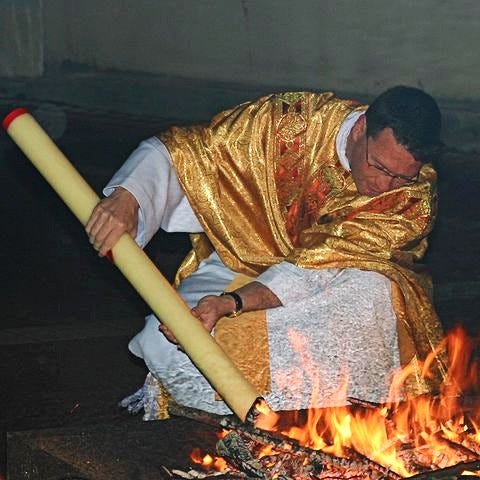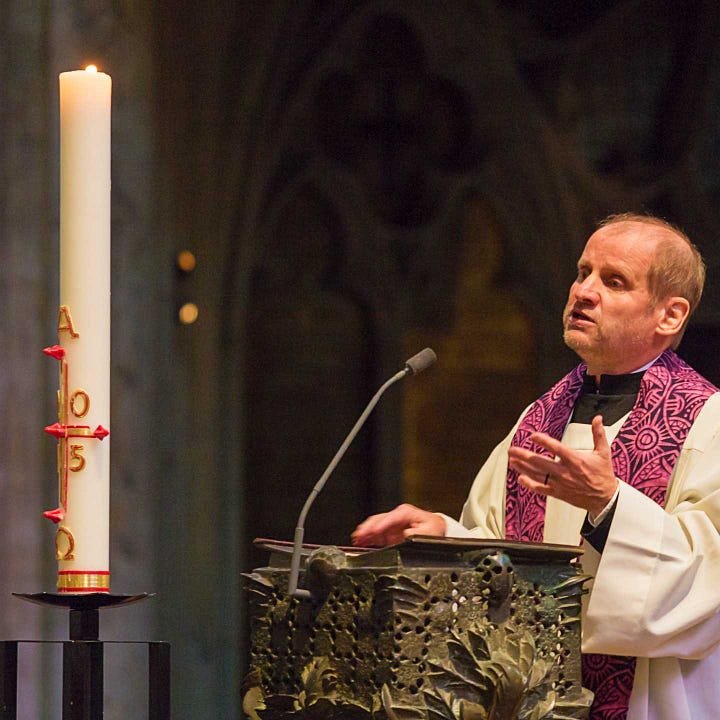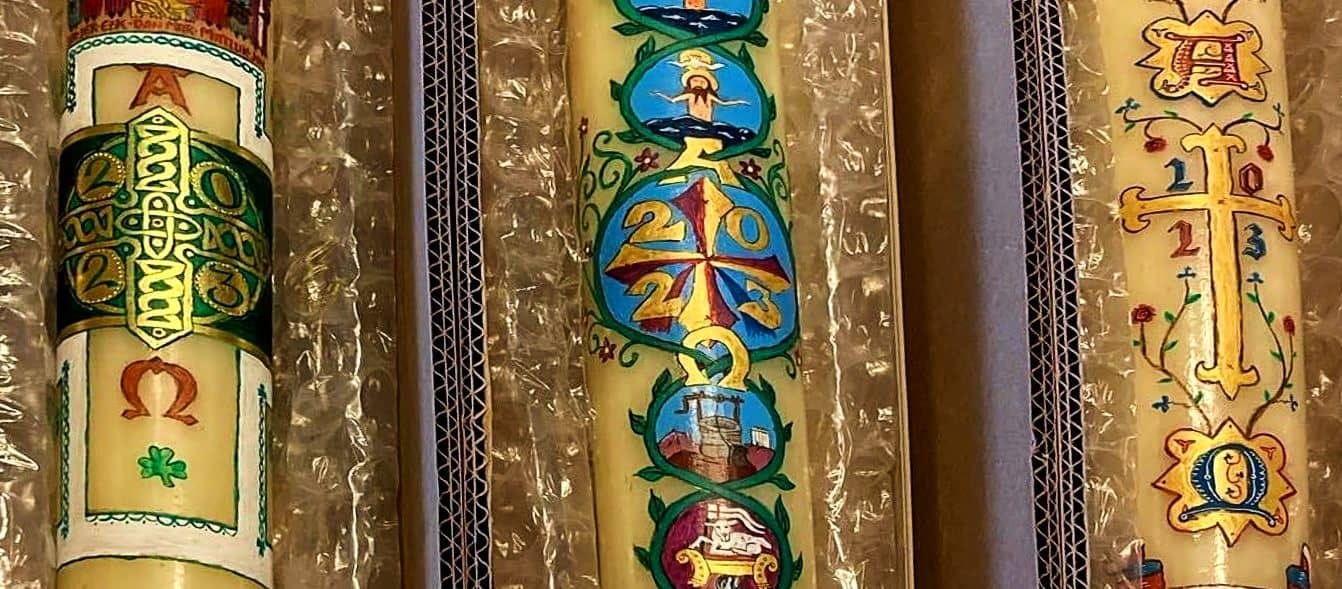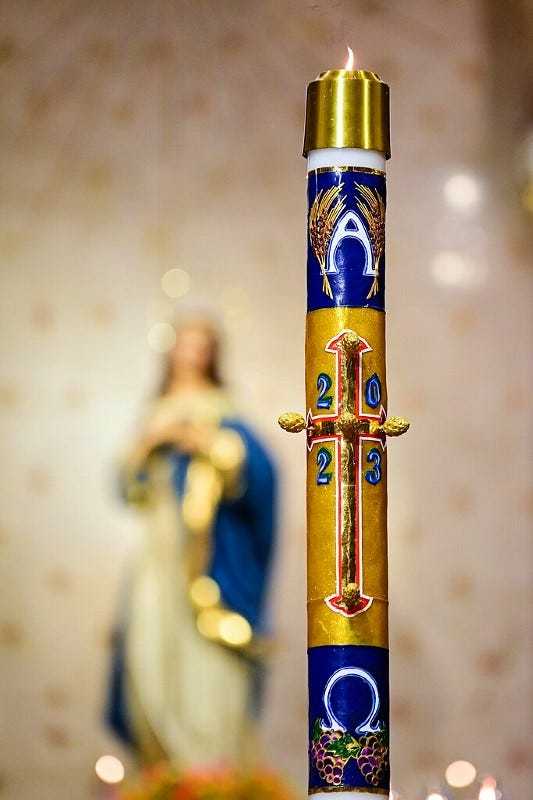The Paschal Candle (more commonly called the Easter Candle) is not just A candle. It is THE candle of the Christian faith in a very literal sense.
No other candle comes close to its importance, its dignity, or its beauty.
Like every other quality candle, it is made of pure beeswax—never paraffin!—and can be lit and blown out by human beings at will. But in a metaphorical sense, it is the only inextinguishable candle in the world. Why?
The Church answers that question through the sacred hymn that is chanted at the Easter Vigil:
But now we know the praises of this pillar,
which glowing fire ignites for God's honor,
a fire into many flames divided,
yet never dimmed by sharing of its light,
for it is fed by melting wax,
drawn out by mother bees
to build a torch so precious.Therefore, O Lord,
we pray you that this candle,
hallowed to the honor of your name,
may persevere undimmed,
to overcome the darkness of this night.Receive it as a pleasing fragrance,
and let it mingle with the lights of heaven.May this flame be found still burning
by the Morning Star:
the one Morning Star who never sets,
Christ your Son,
who, coming back from death's domain,
has shed his peaceful light on humanity,
and lives and reigns for ever and ever. Amen.
Easter Hymn
This beautiful chant is the Easter Proclamation but is often called by its Latin name, the Exsultet. But, of course, the song is not strictly about this candle—it is about the Light of the Risen Christ that the candle represents.
The Church uses a piece of flimsy, malleable material derived from a humble flying creature of the earth and turns it into a glowing symbol of the eternal flame of divine fire that can never be extinguished. Truly astonishing!
Our Catholic faith is so rich, isn’t it?
Here we have an image of four Paschal Candles still in their boxes and wrappings before being used in last year’s Easter Vigil. Below these you can get a sense of the size of these candles in comparison to the priests who minister with them. (Generally, they are four feet tall but can be double that size in the great basilicas.)


A Consecrated Candle
This holy candle, used for these purposes, is not just beautiful, it is also consecrated, or “hallowed to the honor of His name,” because it is a radiant symbol of Christ.
This part of the Easter Vigil ceremony is easy to miss if you are not standing near the priest, but it is extremely beautiful and bears repeating here (if you have the Magnificat missal, it gives the ceremony in full).
After the priest lights the fire in front of the church at the beginning of the Easter Vigil, he takes the candle and consecrates it.
The Church ceremony envisions the priest cutting the Sign of the Cross into the empty wax exterior of the candle, but with the modern ornate candles, the priest only traces the Sign of the Cross over the symbols already emblazoned on the wax.
Note two other elements of the candle: the first and last letters of the Greek alphabet (Alpha [A] and Omega [Ω], which are descriptors of Christ), and the numerals of the current calendar year.
Here are close-ups of the decorative crosses on three of the four Paschal Candles above:
As he traces these signs, the priest solemnly pronounces the following formula:
Christ yesterday and today (vertical beam)
The Beginning and the End (horizontal beam)
The Alpha (A)
And the Omega (Ω)
All time belongs to him (2)
And all the ages (0)
To him the glory and power (2)
Through every age and forever. (4)
Amen.
It’s hard to find a formula that better describes the complete victory of Christ over evil, over life and death, and even over history itself.
Even More Symbolism
But he’s not done consecrating the candle yet!
This ritual is followed by another small gesture by which the priest “pierces” the candle with five grains of incense (symbolizing prayer) in the form of decorative pins that he pushes into the wax at the extremities of the four arms of the cross and into its very center. Again, solemnly he says:
By his holy (1)
And glorious wounds (2)
May Christ the Lord (3)
Guard us (4)
And protect us. (5)
Amen.
Here is a good picture of a finished product:
After these ritual actions, the priest goes on to light the Paschal Candle from the blazing Easter fire outside the church (as in the picture above), saying:
May the Light of Christ rising in glory dispel the darkness of our hearts and minds.
Then, the parishioners light their own candles from the flame of the Paschal Candle and pass the flame from one candle to another through the congregation as they enter the darkened church behind the priest.
As he proceeds down the aisle, the priest lifts the Paschal Candle at three different points and proclaims loudly: Light of Christ, to which the people respond: Thanks be to God!
The symbolism couldn’t be more beautiful: the Light of Christ enters into the darkened world just as the Paschal Candle enters into the lightless church—and pierces the power of darkness forever.
Who would have ever though a simple bit of beeswax could speak so eloquently about our salvation?
----------
If you’d like to hear the chanting of the Easter Proclamation, please see the Sacred Windows article:
Blessed Easter to you and your families from Sacred Windows!
----------
Photo Credits: Four Candles and Detail (Fr Nick Ward); (Priest with Fire (Stucki); Completed Candle (Pauledits); Preacher (Raimond Spekking); Kids holding candles (RaquelSchaar).









Happy Resurrection Day
And if Christ be not risen again, your faith is vain, for you are yet in your sins.
1 Corinthians 15:17
https://www.youtube.com/watch?v=61lvAbTcHUA
radio Easter Sermon, early 1940s , Bishop Sheen, 26 minutes